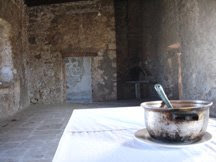
Posted by Alicia Butler.
res·tau·rant
(noun)
A business establishment where meals or refreshments may be purchased.
Gordon Matta-Clark’s experiment, Food, was more of an artists’ commune than a restaurant as it was not a profitable business. In fact, Matta Clark’s then girlfriend, Caroline Goodden, nearly lost all of her money keeping the establishment afloat. Although not classified as an underground supper club at the time, Food started out as a sometimes legal, sometimes illegal dinner party that was a mixture of art and food. Matta-Clark gathered friends and fellow artists to his suppers, usually located in apartments and lofts in Manhattan. It was apparent that he was primarily an artist, and not a cook by trade. Many of his dishes were inedible and he only served them to create a reaction within the space. Food soon took shape in a defunct Puerto Rican restaurant located on 112 Greene Street in SoHo. Many artists used this building not only as a commune to meet other artists with similar ideas, but as a venue in which to display their talents. They would take turns cooking whatever they knew how to make and served up their creations to customers who rarely paid for their meals and when they did, they paid a pittance for what they ate. The artists that worked at Food were able to reconstruct the idea of the restaurant business in New York and undermine the social structure that inevitably followed the industry. By charging very little (and sometimes nothing at all) Matta-Clark found a way to challenge the formal restaurant structure of the 1970’s. Food was sold in 1974 and was finally shut down in the 80’s.





